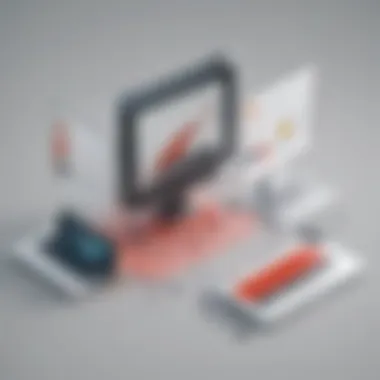Unlocking the Secrets: How to Send Large Video Files Through Gmail for Free


Overview of Cyber Security Threats
When engaging in the digital sphere, one must be attuned to the various cyber security threats that exist. These consist of insidious malware that can infiltrate systems and steal sensitive information, phishing schemes designed to deceive individuals into revealing confidential data, and the menacing ransomware that encrypts files and demands payment for their release. Statistics reveal a concerning trend in cyber attacks, with a growing number of incidents reported annually. Real-life examples further underscore the importance of vigilance, such as the high-profile breaches of major corporations resulting in massive data leaks.
Best Practices for Online Security
Implementing best practices for online security is crucial in safeguarding sensitive data and personal information. This includes creating and managing robust passwords that are difficult to decrypt, regularly updating software to mitigate vulnerabilities, and adopting two-factor authentication for an added layer of protection. These measures help fortify digital defenses and reduce the risk of falling victim to cyber threats.
Reviews of Security Tools
When considering security tools, evaluating the effectiveness of antivirus software is paramount. Additionally, comparing the features and performance of various firewall protection options aids in selecting the most suitable solution for enhanced security. Moreover, assessing the functionality of password managers enables users to securely store and manage their login credentials, bolstering data protection across multiple online accounts.
Tips for Ensuring Online Privacy
Maintaining online privacy requires conscientious efforts, such as utilizing Virtual Private Networks (VPNs) to establish secure connections and anonymize internet activities. Adhering to stringent privacy settings on social media platforms helps control the dissemination of personal information. Furthermore, exercising caution during online transactions by safeguarding sensitive data minimizes the risk of unauthorized access and potential privacy breaches.
Educational Resources and Guides
Educational resources play a vital role in empowering individuals with the knowledge to enhance their online security practices. Accessing how-to articles on setting up encryption tools aids in securing communications and data transmissions. Step-by-step guides on identifying and thwarting phishing emails equip users with the skills to recognize and avoid common online scams. Additionally, utilizing cheat sheets simplifies the process of bolstering online security protocols, facilitating quick and effective implementation.
Introduction to Sending Large Video Files via Gmail
Sending large video files via Gmail is a crucial aspect of modern communication. In the digital age, where visual content reigns supreme, mastering the art of efficiently sharing videos through email can significantly elevate online interactions. This section serves as the gateway to understanding the complexities and nuances of leveraging Gmail for seamless video file transfers. By exploring Gmail's file size limits, optimizing videos for email compatibility, and venturing into alternative transfer methods, users can enhance their online experience through efficient multimedia communication.
Understanding Gmail's File Size Limits
Determining Maximum File Size Allowed by Gmail


When delving into the world of sending large video files through Gmail, one must first grasp the limitations set by the platform. Understanding the maximum file size allowed by Gmail is imperative for successfully transmitting videos without encountering size-related hurdles. Gmail's file size limit plays a pivotal role in dictating the scope and quality of videos that can be shared via email. By recognizing and adhering to these restrictions, users can navigate the email attachment process with precision and efficiency.
Implications of Exceeding File Size Limits
Exploring the implications of exceeding Gmail's file size limits sheds light on the potential challenges and consequences of surpassing these boundaries. When users attempt to send videos that are larger than the specified limits, issues such as failed uploads, delivery delays, and incomplete transfers may arise. Understanding these implications underscores the importance of optimizing video file sizes and utilizing alternative transfer methods when dealing with large multimedia files via Gmail.
Utilizing Google Drive for Large Video Files
Uploading Videos to Google Drive
Utilizing Google Drive for storing and sharing large video files presents a practical solution to Gmail's file size constraints. By uploading videos to Google Drive, users can bypass email attachment limitations and streamline the sharing process. This method ensures that recipients can access and download the videos seamlessly, enhancing the overall user experience. Leveraging Google Drive as a supplementary platform for video storage empowers users to overcome size-related challenges and optimize their multimedia communication.
Link Sharing Options
When sharing large video files through Google Drive, exploring link sharing options provides users with versatility and control over file access. By generating shareable links with customizable permissions, users can determine who can view, download, or edit the videos stored on Google Drive. This feature enables efficient collaboration and content distribution among individuals or groups, enhancing the functionality and accessibility of shared video files.
Optimizing Video Files for Email
Compression Techniques
Optimizing video files through compression techniques is essential for enhancing email attachment efficiency and reducing file sizes without compromising quality. By utilizing compression software or tools, users can tailor the size of video files to meet Gmail's limitations while maintaining satisfactory viewing quality. Balancing compression ratios with video resolution ensures that emails containing videos load quickly and transmit smoothly, minimizing upload issues and enhancing user experience.
File Formats for Compatibility
Selecting appropriate file formats for video compatibility in emails is crucial for seamless playback across different devices and platforms. By choosing universally supported formats such as MP4 or MOV, users ensure that recipients can view the videos without encountering playback errors or formatting issues. Prioritizing compatibility when selecting video file formats optimizes the viewing experience for email recipients, fostering smooth communication and content sharing.
Sending Videos as Email Attachments
Sending videos as email attachments is a crucial aspect of this comprehensive guide on sending large video files through Gmail for free. By focusing on this topic, we can address specific elements that play a vital role in facilitating seamless video sharing via email. Understanding the importance of efficiently attaching videos to emails can help users maximize the utility of Gmail for file transfer. Considerations such as file size limits, attachment methods, and email etiquette will be elaborated upon to provide a holistic view of sending videos via email.


Splitting Large Videos for Email Attachment
Tools for Video Splitting
The tools for video splitting encompass software and applications designed to divide large video files into smaller segments for convenient email attachment. These tools are instrumental in overcoming Gmail's file size limitations, enabling users to send videos that would otherwise exceed the size restrictions. Their key characteristic lies in their ability to efficiently split videos without compromising quality, making them a popular choice for users seeking to send large video files through email. The unique feature of these tools is their user-friendly interface and seamless integration with various video formats, offering advantages such as ease of use and compatibility.
Step-by-Step Splitting Process
The step-by-step splitting process delineates the systematic approach to dividing large video files using the aforementioned tools. This process is essential for users looking to segment their videos effectively while ensuring each segment remains within Gmail's attachment size limits. The key characteristic of this process is its precision in dividing videos, guaranteeing that each segment can be attached to an email seamlessly. Its popular choice stems from its simplicity and effectiveness in managing large video files for email transmission. The unique feature of this process is its versatility, allowing users to customize segment sizes according to their needs, offering advantages such as flexibility and customization.
File Compression for Gmail Attachment
Choosing the Right Compression Software
Selecting the right compression software is integral to optimizing video files for email attachment, balancing between file size reduction and maintaining quality. This aspect contributes significantly to the overall topic by ensuring that videos remain manageable for email transfer while retaining their visual integrity. The key characteristic of suitable compression software is its ability to efficiently reduce file sizes without markedly impacting video quality, making it a beneficial choice for users looking to send large video files through Gmail. The unique feature of this software lies in its compression algorithms that intelligently shrink file sizes while preserving essential visual content, offering advantages such as expedited file transfer and enhanced storage efficiency.
Balancing Quality and Size
Balancing quality and size in video compression is paramount for achieving optimal results when sending videos via email. This process is crucial for users aiming to strike a harmonious balance between video clarity and manageable file sizes. The key characteristic of this approach lies in its capacity to adapt compression settings to retain a satisfactory level of video quality while reducing overall file size. Its beneficial choice status originates from its capacity to provide users with control over compression ratios, allowing for customization according to their preferences. The unique feature of this process is its ability to preserve video details while ensuring compact file sizes, offering advantages such as enhanced viewing experience and efficient storage utilization.
Additional Tips for Sending Videos via Email
Subject Line Etiquette
Subject line etiquette plays a pivotal role in email communication, particularly when sending videos to recipients. This aspect contributes to the overall topic by enhancing email professionalism and effectively conveying the video's content or purpose. The key characteristic of subject line etiquette is its ability to succinctly summarize the video's essence while prompting recipients to engage with the email. It is a beneficial choice for users as it improves email relevance and recipient engagement. The unique feature of subject line etiquette is its capacity to capture attention and communicate essential information concisely, offering advantages such as increased email open rates and clearer communication.
Security Considerations
Prioritizing security considerations when sending videos via email is imperative to safeguard sensitive content and protect user privacy. This aspect significantly contributes to the overarching theme by underscoring the importance of secure video transmission methods. The key characteristic of security considerations is their ability to mitigate potential risks associated with video sharing, ensuring data integrity and confidentiality. It is a beneficial choice for users concerned about online security as it fortifies email communication against unauthorized access and data breaches. The unique feature of security considerations is their role in reinforcing trust between senders and recipients, offering advantages such as enhanced data protection and peace of mind.


Exploring Alternative Methods for Large Video Transfer
In the realm of digital communication, the exploration of alternative methods for large video transfer holds a pivotal role in this treatise. For individuals seeking efficient ways to exchange sizable video files, understanding diverse transfer options beyond traditional emailing becomes imperative. Embracing a comprehensive approach, this section dissects the intricacies of utilizing varied platforms to ensure seamless file sharing experiences.
Using Third-Party Services
We
Transfer, Dropbox, and More
Delving into the crux of third-party services like We Transfer and Dropbox unveils a realm of possibilities within the purview of large file transfers. These platforms present users with a user-friendly interface and robust infrastructure tailored for swift and secure data transmission. The convenience of drag-and-drop functionality coupled with customizable sharing settings makes them a preferred choice for professionals and casual users alike. However, while these services excel in user-friendliness and accessibility, concerns regarding data privacy and limited free storage options may arise, warranting caution amidst the convenience they offer.
Comparative Analysis
Within the domain of large file transfers, conducting a comparative analysis proves invaluable in delineating the strengths and weaknesses of various third-party service providers. By evaluating key metrics such as file size limits, transfer speeds, and security protocols, users can make informed decisions tailored to their unique requirements. Such an analytical approach enables individuals to leverage the strengths of platforms like We Transfer and Dropbox while mitigating potential drawbacks, ensuring a nuanced and holistic perspective when navigating the expansive landscape of video file transfers.
Integration with Email Clients
Outlook, Yahoo Mail, and Gmail Integration
The seamless integration of popular email clients like Outlook, Yahoo Mail, and Gmail within the scope of large file transfers represents a significant boon for individuals seeking streamlined communication channels. With intuitive features enabling direct attachments and cloud storage linkage, these integrations afford users the flexibility to send bulky video files effortlessly. While the integration streamlines the sharing process, considerations regarding attachment file size limits and recipient compatibility underscore the need for judicious utilization of these integrated services.
Pros and Cons
Evaluating the pros and cons associated with email client integrations offers users a deeper understanding of the advantages and limitations inherent to these streamlined communication solutions. From expedited sharing capabilities to potential compatibility constraints, weighing the benefits against the constraints polishes users' comprehension of efficient file transfer methodologies. By elucidating the diverse facets of email client integration, this section equips readers with the foresight to optimize their digital communication practices effectively.
Future Trends in File Transfer Technology
Blockchain-Based Solutions
The integration of blockchain-based solutions heralds a paradigm shift in the landscape of file transfer technology, introducing decentralized and immutable frameworks for enhanced data security and transparency. By leveraging blockchain's distributed ledger technology, users can partake in secure and verifiable file transfers devoid of intermediary intervention. This innovative approach not only fortifies data integrity but also fosters trust among participants, carving a path towards a more robust and tamper-resistant file transfer ecosystem.
Enhanced Encryption Protocols
Embracing enhanced encryption protocols bolsters the pillars of data security within the realm of file transfers, fortifying sensitive information against potential cyber threats and unauthorized access. By implementing cutting-edge encryption algorithms and stringent security measures, users can safeguard their video files from prying eyes and malicious entities, ensuring end-to-end protection throughout the transmission process. This section delves into the nuances of encryption protocols, elucidating their significance in fortifying digital communications and upholding privacy standards.





